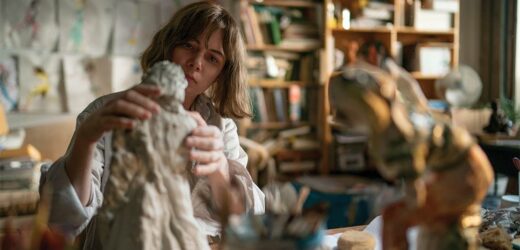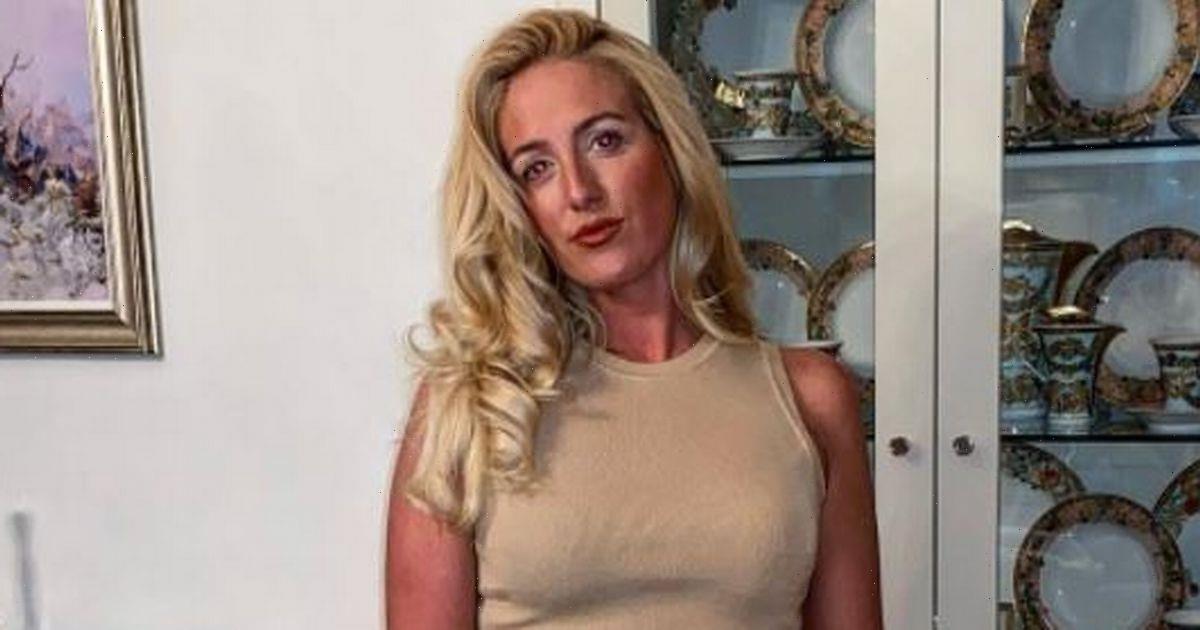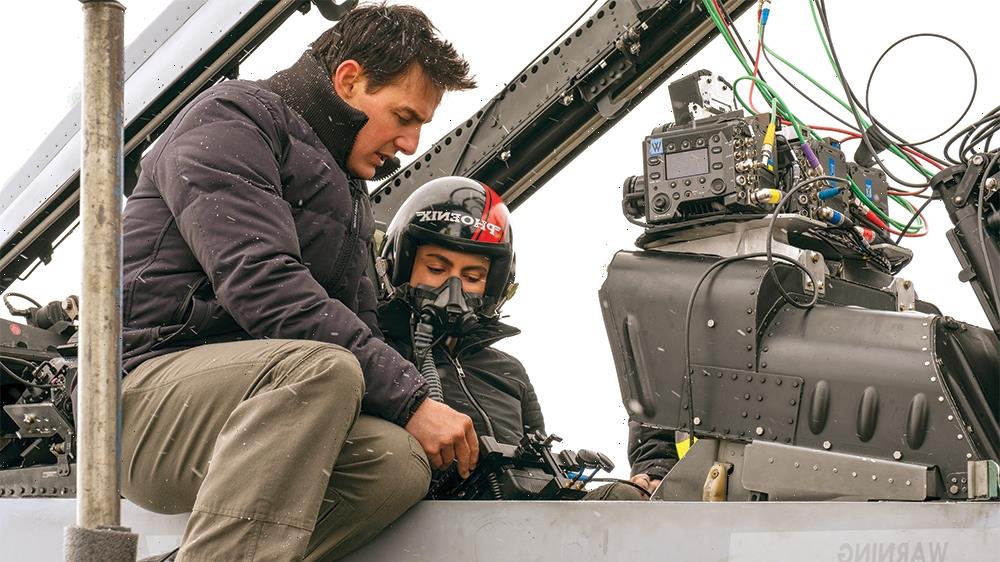Lizzy Carr (Michelle Williams), the central character of Kelly Reichardt’s “Showing Up,” is a sculptor who is finishing up a series of ceramic figures she’ll be presenting in a gallery show. We see her working, throughout the movie, on the small clay statues — all women, each one about a foot tall, some mounted on rods, all with an intentionally rough, patchy surface that may look awkward and unpolished if you’re close up to it, but when you stand back a bit you see the aesthetic elegance of her style. (Giacometti would understand.) She’s making sculptures of female characters who look a bit ghostly in their lack of perfect line, but that’s part of their design (they all appear a little tormented), and that quality is balanced by the delicate surprise colors they’re painted with, which express their inner life. There’s no question: Lizzy has talent. And devotion. With a kind of meticulous calm, she pours herself into creating and honing these objects.
What she doesn’t have is a career as an artist. She’s getting her own show because she’s finishing up her studies at the Oregon College of Art and Craft in Portland, the city she’s from. She’s a serious artist, as are many of her fellows. The school is full of people doing fresh quirky imaginative work, and that makes them feel separate from the hoi polloi; it’s a community of creative souls. Yet the larger art world they have their eye on is so competitive and demanding that the chances of any one of them succeeding in it is, in fact, quite small.
There’s no shame, of course, in being a creative person who doesn’t earn a living at it. That’s been part of the story of American middle-class life ever since the 1960s — the tapping of impassioned artistic energies by ordinary people (artists, poets, actors), even if they’re not brilliant or ambitious or just plain lucky enough to make it. To the extent that we in the audience can judge what Lizzy does (her sculptures are actually the work of the Portland-based artist Cynthia Lahti), we look at it and think: Yes, she’s good enough. But there’s a poignance — and maybe a special dilemma — to that. Art, from what we can tell, is more or less the only thing Lizzy cares about. So what’s the meaning of her life if she doesn’t succeed at becoming an artist, and for her all talent her sculptures turn out to be…a hobby?
Part of the gentle enchantment of “Showing Up” is that the film never articulates that question — at least, not in the way I just did. On the contrary, it’s a movie of feints, digressions, sidelong humor, and the randomness of life intruding on the purpose of life. I’d argue, however, that the question hovers in the background, since Lizzy seems to cling to art like a survival raft. You could simply call her a student, and you’d be right, but what she really is is a bohemian. She rents a red-cedar-shingled apartment, with a garage studio on the bottom floor, from Jo (Hong Chau), a landlord who’s also her art colleague and sort-of-friend (she’s a student at OCAC too), but the hot water hasn’t been working for days, and Jo hasn’t bothered to fix the heater; she’s too busy putting together her own gallery show (of an installation that looks like Alexander Calder working in yarn).
It’s no fun living without hot water (Lizzy hasn’t taken a shower in days), but more than that it’s humiliating. It’s a sign of her desperate straits. Lizzy, who appears to be in her 30s, is living hand-to-mouth, working in the office of the college sculpture magazine, which is run by her mother, Jean (Maryann Plunkett), who is just free-spirited yet snappish enough that you glimpse the former hippie in her. Lizzy’s dad, Bill (Judd Hirsch), is a sculptor too — a potter who found enough success to rub shoulders with the art world. So even though he and Lizzy have that in common, she’s working in his shadow. Her parents, long divorced, are all about themselves. And so, in her passive sheepish mopey way, is Lizzy.
“Showing Up” takes place over the course of a week, and to say that not much happens in it would be at once true, totally inaccurate, and a description of the film’s strangely engrossing micro slice-of-life beauty. Not much happens beyond Lizzy’s day-to-day travails — unless, that is, you count the things that do happen as expressions of the drama of life. Michelle Williams plays Lizzy in a wavy mop of brown hair, with a slight frown, so that her whole demeanor seems repressed and a bit frumpy. But Williams, who starred in Reichardt’s finest film, the irresponsible-young-woman-and-her-dog drama “Wendy and Lucy” (2007), is a magician of an actor — or maybe, in her own way, a sculptor too. For a long time, she doesn’t “reveal” much, but that’s quite intentional, as she cues us to read everything Lizzy is holding back.
The artist, in this case, has developed where the person hasn’t. Lizzy’s silent obsessiveness turns “Showing Up” into a story of caring about something to the point that it takes over your life. André Benjamin brings a sly charisma to the role of the school associate who operates the kiln, and he has encouraging words for all the artists, but when a side of one of Lizzy’s sculptures gets overcooked in the oven, his it’s-all-good! attitude chafes at her; she thinks the piece is ruined. Is it? Caring that much is Lizzie’s dysfunction, and maybe her glory. It’s what a lot of artists are about. But as the movie goes on, she lets a little more life in.
Reichardt, a lone artist herself (she’s a celebrated filmmaker, but it was recently reported that she teaches at Bard in order to get health insurance), has shot most of her movies in Portland, which is now the last stop for a certain kind of neo-’60s spiky utopian idealism, and she surveys this community of creatives with a blend of affection and acerbic comedy that never slips over into satire. In its minimalist quotidian way, “Showing Up” is a movie made by someone in masterly control of her medium.
Bit by bit, the dramas of the everyday gather steam: Jo’s passive-aggressive refusal to fix the water heater; the fate of Lizzy’s brother, Sean (John Magaro), who strikes us at first as a hostile incel and then, by the end, as possibly schizophrenic (he’s a little like one of R. Crumb’s brothers); and the drama of a wounded pigeon, which Lizzy callously tosses out of her house after her orange cat has chomped its wing, then Jo rescues it, then Lizzy takes over its care, which is really about her learning to nurture — the bird and herself. The movie’s title means: She shows up for others, but will she show up for herself? That, in fact, is one of the defining perils of bohemianism: what you sacrifice for love, or art, without the looking out for number one that’s required in the real world.
At last, Lizzy’s show happens. And by the time it does, Reichardt has folded in a suspenseful question: Will Marlene (Heather Lawless), the college’s current artist-in-residence, who has taken a liking to Lizzy and even voiced approval of her work as it came out of the kiln, make it to the opening? That question is all about success — about the possible connection to a New York gallery that she could offer. So in a way everything hinges on it. But in another way nothing hinges on it. Because either way life will go on. “Showing Up” may be too quiet to find a large audience, but in its lovely way it locates that place where art and life intersect, as each becomes the other.
Source: Read Full Article


